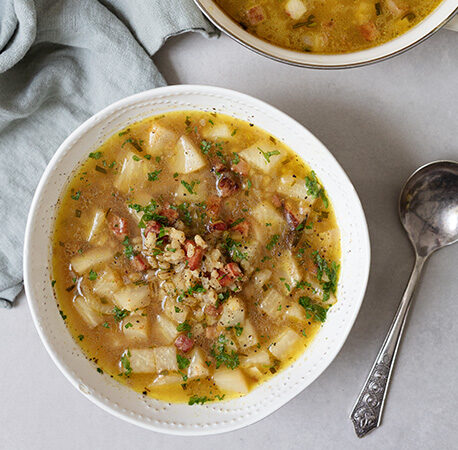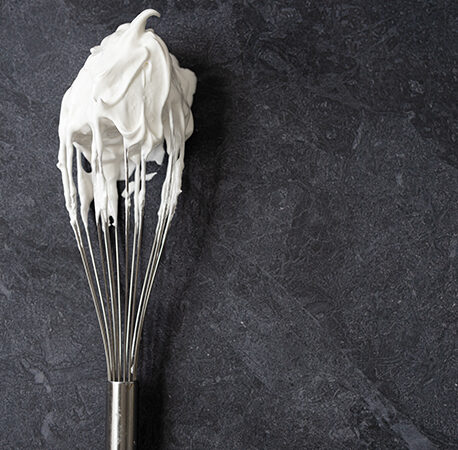Guest editor Rich Harris gave us his top tips for becoming a pitmaster.
Why not put your BBQ skills to the test with our best classic barbecue menu here.
Direct versus indirect grilling
You’ll see that these recipes are either cooked over direct or indirect heat, or occasionally a combination of both. Read on to learn the difference.
Direct grilling
Direct grilling is exactly what it says on the tin: the grill is positioned directly over the heat source.
- This is what you probably think of as traditional barbecuing; it’s a way of cooking hard and fast, giving food an intense chargrilled flavour.
- The biggest mistake people make is treating a barbecue like a griddle pan or frying pan and leaving a piece of meat sitting in one position, which can either lead to it burning or taking too long to cook.
- People worry that they’ll lose that lovely charred crust, but that will come towards the end of cooking. Equally, if the heat is fairly moderate, it’s just as important to keep the food moving.
- Rather than simply turning that lovely piece of meat in the same spot, turn and then move it to another part of the grill and you’ll get a deep char on the meat, resulting in even better flavour.
Indirect grilling/hot smoking
This is low and slow cooking; the heat source and the food need to be separated and the heat diffused to prevent the food from cooking too quickly.
Indirect grilling set-up
- Build your fire as usual, and when the coals are glowing white, push everything to one side.
- Lay a foil tray filled with water next to the coals and set the grill over the top.
- Lay another water-filled tray on the grill directly above the glowing coals.
- The food goes on the empty half of the grill.
- Airflow is important; to maintain a really low temperature (about 125˚C is ideal), keep the air intake at the bottom of the barbecue and exhaust at the top to a minimum.
- Once food has been added, close the lid and adjust the top and bottom vents to maintain a steady temperature.
Be sure to try our 10 delicious meat-free recipes for your next barbecue
Charcoal
- Depending on the type of charcoal you’re using, and the type of barbecue or smoker, you may need to top up the fuel during indirect cooking.
- This is where a chimney starter comes in really handy as it allows you to get the coals to the right temperature before topping them up.
- Don’t try to add ‘cold’ charcoal or wood straight to the fire as their initial burn will give off acrid smoke, tainting the flavour of the food.
Getting that smoky flavour
- If you want to increase the smoky flavour from low and slow cooking, add hardwood chunks to your charcoal.
- Do ensure the wood is properly charred and only gently smouldering before you start cooking; if thick smoke is billowing it will give the food an acrid taste.
- For faster recipes, apply smoking pellets directly to the coals, or soak smoking chips in warm water for 30 minutes before adding.
Here are 7 side dishes to bring your BBQ to the next level!
Your ultimate barbecuing kit
Digital probe thermometer: There are loads of these on the market and some can be linked to a smartphone. Try a wireless probe, which is inexpensive and means that you can leave meat cooking outside and keep an eye on its progress without having to stand by the barbecue for hours.
Long matches: Because nobody likes burnt fingers.
Chimney starter: This will help to get your barbecue fuel going quickly and efficiently, and is useful for topping it up during long cooks.
Heavy-duty black rubber gloves: For handling charcoal and making the neighbours think that you’re a bit sinister.
Old, clean tea towels: To help with handling large pieces of meat during cooking.
Foil trays or old roasting trays: To hold food as it cooks or for use as water trays for indirect cooking; foil trays are reusable, and both save ruining your nice non-stick trays.
Spray bottle: For spritzing meat to keep it moist during cooking, and to remove any excess smoke particles (which can make the meat bitter). Also handy to fill with oil for spraying the bars on the grill.
A couple of old, heavy-based saucepans: For cooking sauces on the grill.
Learn how to make your own barbecue sauce at home
Ideal cooking temperatures
This list is handy when consulting a digital read thermometer. It shows the temperature at which you need to remove the meat from the grill, and the final temperature you want after resting.
BEEF AND LAMB
Rare
Temperature out of the barbecue: 50°C
Temperature after resting: 56°C
Medium rare
Temperature out of the barbecue: 56°C
Temperature after resting: 62°C
Medium
Temperature out of the barbecue: 62°C
Temperature after resting: 68°C
Well done
Temperature out of the barbecue: 68°C
Temperature after resting: 72°C
PORK
Medium
Temperature out of the barbecue: 60°C
Temperature after resting: 70°C
Well done
Temperature out of the barbecue: 70°C
Temperature after resting: 80°C
CHICKEN AND TURKEY
Temperature out of the barbecue: 68°C
Temperature after resting: 75°C
If you are looking for some tasty barbeque recipes to enjoy this summer be sure to try our 11 most incredible burger recipes.
- summer events
- small business
- gut health
- OATLY
- healthy
- Crudo
- top tips
- All Together Now
- fridge cake
- Events Waterford
- me auld flower
- Events Ireland
- food festival
- news
- dublin
- events Dublin
- dublin festival
- Home-Cooking
- food and drink festival
- online cooking course
- festival line-up
- cooking
- Summer festival
- eco-friendly
- Events
- cosy
- Festivals Ireland
- wine
- Body & Soul
- grapes
- music festival
- south africa






You have to be signed in to comment this post.